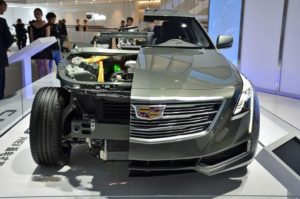

As word spread last week that Tesla is likely to change to hexagonal from the cylindrical batteries it has used for a decade, GM that usurped the whole efficiency debate by showing off their innovative new flat pack batteries they call “Ultium”. They are higher density at a much lower cost than any other companies battery pack and can be charged at a massive 800V providing a 100 miles of range in just 10 minutes.
It appears that GM will be the first company to get their battery packs below the magical $100 per kW hour rate and that puts GM in the lead, ahead of even Tesla.
This battery pack on a skateboard are the basic elements of the BEV3 platform that dozes on future GM vehicles will use. So far, it has been announced on the forthcoming small Cruise Origin autonomous transport, the very large GMC Hummer EV and the Cadillac Lyriq EV but it will not be used on the 2021 refresh of the Chevy Bolt.
GM says that this technology is so innovative that other auto manufacturers will be licensing it from the General.
Note that the Cadillac Lyriq will be sold in China in mid 2021 and then in Canada and the US the following year.
The official Ultium press release states:
Ultium Batteries and Propulsion System Highlights
- GM’s new Ultium batteries are unique in the industry because the large-format, pouch-style cells can be stacked vertically or horizontally inside the battery pack. This allows engineers to optimize battery energy storage and layout for each vehicle design.
- Ultium energy options range from 50 to 200 kWh, which could enable a GM-estimated range up to 400 miles or more on a full charge with 0 to 60 mph acceleration as low as 3 seconds. Motors designed in-house will support front-wheel drive, rear-wheel drive, all-wheel drive and performance all-wheel drive applications.
- Ultium-powered EVs are designed for Level 2 and DC fast charging. Most will have 400-volt battery packs and up to 200 kW fast-charging capability while our truck platform will have 800-volt battery packs and 350 kW fast-charging capability.
GM’s flexible, modular approach to EV development will drive significant economies of scale and create new revenue opportunities, including:
Continuous Improvement in Battery Costs: GM’s joint venture with LG Chem will drive battery cell costs below $100/kWh. The cells use a proprietary low cobalt chemistry and ongoing technological and manufacturing breakthroughs will drive costs even lower.
Flexibility: GM’s all-new global platform is flexible enough to build a wide range of trucks, SUVs, crossovers, cars and commercial vehicles with outstanding design, performance, packaging, range and affordability.
Capital Efficiency: GM can spend less capital to scale its EV business because it is able to leverage existing property, including land, buildings, tools and production equipment such as body shops and paint shops.
Complexity Reduction: The vehicle and propulsion systems were designed together to minimize complexity and part counts beyond today’s EVs, which are less complex than conventional vehicles powered by internal combustion engines. For example, GM plans 19 different battery and drive unit configurations initially, compared with 550 internal combustion powertrain combinations available today.
Rising Customer Acceptance: Third-party forecasters expect U.S. EV volumes to more than double from 2025 to 2030 to about 3 million units on average. GM believes volumes could be materially higher as more EVs are launched in popular segments, charging networks grow and the total cost of ownership to consumers continues to fall.
New Sources of Revenue: By vertically integrating the manufacture of battery cells, the company can reach beyond its own fleet and license technology to others.
This website uses cookies.